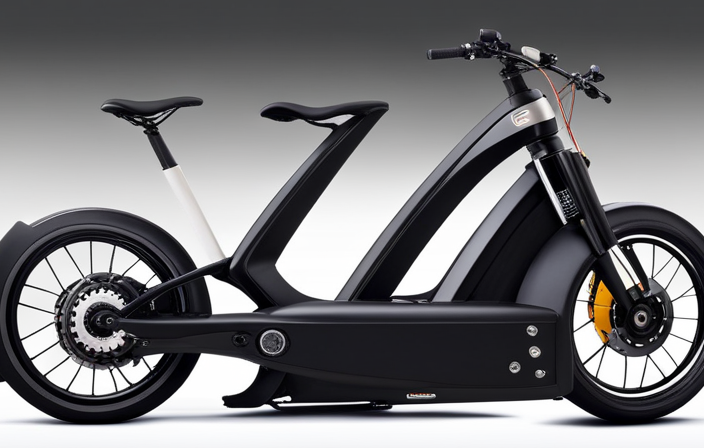To keep your cycling or e-bike battery healthy, avoid frequent fast charging and keep it in cool, dry places. Don’t let it fully discharge or stay at 100% charged for too long. Use smart chargers and maintain moderate, regular cycling patterns to reduce stress. Proper storage, avoiding extreme temperatures, and checking its condition help prolong lifespan. Stay aware of signs of decline, and you’ll discover even more tips for maximizing your battery’s performance.
Key Takeaways
- Avoid frequent fast charging and high temperatures to prevent battery degradation and extend lifespan.
- Maintain charge levels between 50-70% during storage for optimal battery health.
- Regularly monitor and calibrate your battery, avoiding deep discharges to preserve capacity.
- Use smart chargers with proper voltage regulation to prevent overcharging and overheating.
- Opt for smooth, flat routes and moderate cycling patterns to reduce strain and prolong battery performance.
Understanding Your Battery: Types and How They Work

Understanding your battery begins with knowing the different types and how they operate. Battery chemistry determines the materials used inside, affecting capacity, lifespan, and safety. Common types include lithium-ion, nickel-metal hydride, and lead-acid, each with unique characteristics. Cell configuration refers to how individual cells are arranged within the battery—series or parallel—impacting voltage and capacity. For example, lithium-ion batteries often use cylindrical or pouch cells arranged in specific configurations to optimize performance. Knowing these aspects helps you grasp how your battery stores and delivers energy. An understanding of Battery chemistry is essential for selecting and maintaining the right battery for your needs. This knowledge allows you to better care for your battery, ensuring it performs efficiently and lasts longer. Recognizing the chemistry and configuration is the first step toward understanding your battery’s behavior and limitations.
Charging Habits That Protect Your Battery’s Longevity

Proper charging habits are key to maintaining your battery’s health and extending its lifespan. Avoid frequent fast charging, as it can generate excess heat and accelerate battery degradation. Instead, opt for standard charging whenever possible, especially for daily use. Temperature management is vital—charge your battery in a cool, dry place and avoid exposing it to high temperatures during charging, which can harm cell chemistry. Don’t let your battery sit at 100% for long periods; unplug it once fully charged to prevent stress. Similarly, avoid letting the battery drain completely before recharging. Keeping your battery within ideal charge levels and managing heat effectively helps preserve its capacity and longevity, ensuring your e-bike remains reliable and efficient for years to come. Additionally, understanding the importance of contrast ratio can help you choose the right projector for your home cinema setup, as it impacts the depth and clarity of images.
The Impact of Cycling Patterns on Battery Health

Your cycling patterns directly influence your e-bike battery’s health. How often you ride and the terrain you tackle play significant roles. Frequent cycling can help keep your battery in good shape, as shallow charge cycles are gentler on the cells. However, riding on hilly or rough terrain increases the strain on your battery, causing it to cycle more deeply and wear out faster over time. Consistently riding on smooth, flat surfaces reduces stress and extends battery life. Additionally, long, intense rides may lead to higher voltage swings, which can degrade the battery quicker. To preserve your battery’s health, aim for moderate cycling frequency and vary your routes to avoid prolonged exposure to demanding terrains. This balanced approach helps maintain ideal battery performance over the long term. Proper battery tuning can also enhance longevity and performance.
Best Practices for Storage and Maintenance

To keep your battery in top shape, focus on storing it in ideal conditions, like cool, dry environments away from direct sunlight. Regular maintenance checks help identify issues early and guarantee your battery stays healthy. Additionally, practicing proper charging techniques ensures optimal battery performance and longevity. By following these practices, you’ll extend your battery’s lifespan and maintain reliable performance.
Optimal Storage Conditions
Storing batteries properly is essential to maintaining their health over time. To avoid damage, keep your battery in a cool, dry place away from temperature fluctuations. Extreme heat accelerates capacity loss, while cold can reduce performance temporarily. Aim for a stable temperature, ideally around 50°C (122°F). Humidity control is equally important; high humidity can cause corrosion and internal damage. Use a sealed container or store in a location with low humidity levels. Never store batteries in direct sunlight or damp environments. Make sure the battery is partially charged—around 50-70%—before storage, and check it periodically. Proper ventilation can also prevent moisture buildup and maintain a healthy environment for your batteries. By maintaining a stable environment with controlled humidity and minimal temperature swings, you prolong your battery’s lifespan and ensure reliable performance when you need it.
Regular Maintenance Checks
How often should you perform maintenance checks to guarantee your battery stays in ideal condition? Regular checks ensure peak performance and longevity. You should inspect your battery every 3 to 6 months, especially if stored unused. During these checks, focus on battery calibration to keep voltage readings accurate and electrolyte maintenance if you have a liquid electrolyte system. Proper calibration prevents misdiagnosis of capacity loss, while electrolyte upkeep ensures electrolyte levels remain balanced. Use the table below as a quick guide:
| Check Frequency | Key Focus | Notes |
|---|---|---|
| Every 3-6 months | Battery calibration | Use compatible calibration tools |
| Annually | Electrolyte maintenance | Top off or replace electrolyte if needed |
| After long ride | Visual inspection | Look for corrosion or damage |
| Before storage | Full charge | Prevent deep discharge |
| Monthly | Voltage check | Detect early issues |
Additionally, regular maintenance checks can help identify potential issues early, ensuring your cycling & E‑bikes remain in optimal condition.
Recognizing Signs of Declining Battery Performance
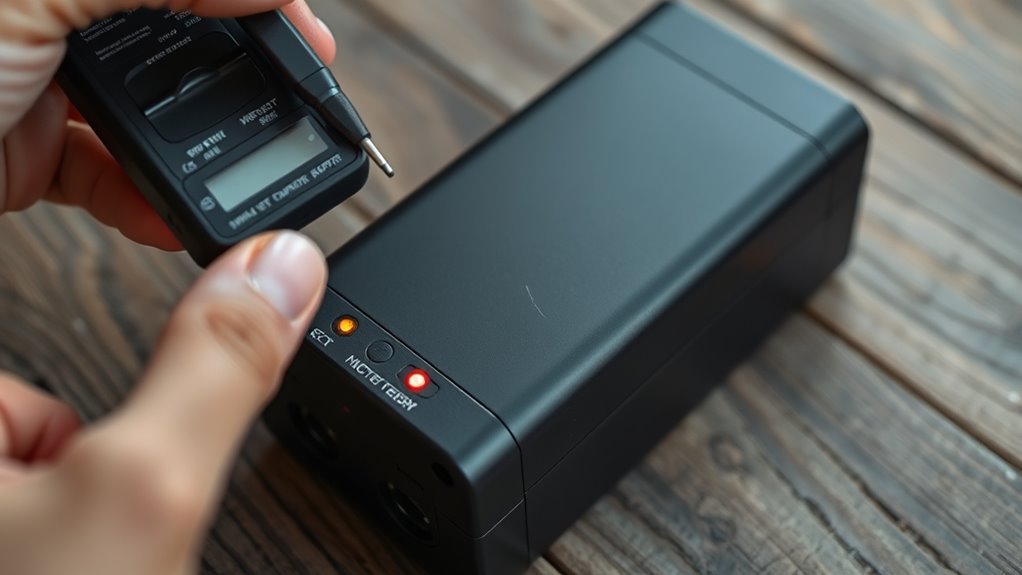
As your device’s battery begins to age, you might notice it doesn’t hold a charge as long as it used to. This is a clear sign of battery degradation and performance decline. You may find yourself needing to recharge more frequently or experiencing sudden drops in power. Reduced range on your e-bike or cycling device is another indicator that the battery’s capacity is shrinking. Additionally, if your battery takes longer to charge or feels unusually warm during use or charging, these are signs of declining health. Over time, these symptoms become more pronounced, signaling it’s time to evaluate replacing the battery or seeking professional maintenance. Recognizing these signs early can help you maintain peak performance and extend your device’s lifespan. Being aware of battery capacity, which decreases over time, can help you better understand when it’s time for replacement or service.
Myths and Facts About Battery Care
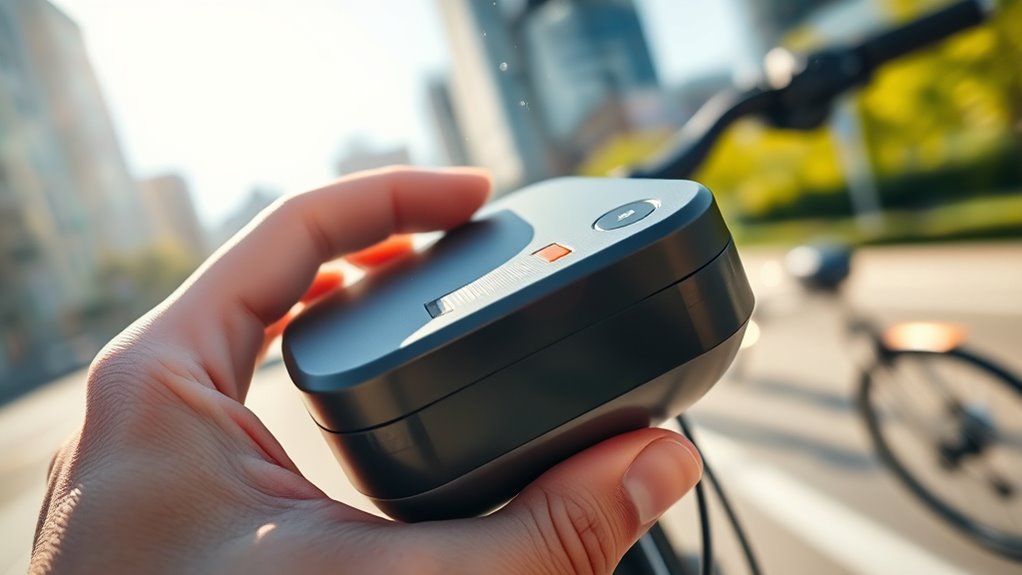
Many common beliefs about battery care are actually myths that can harm your device’s longevity. For example, some think fully discharging your battery is necessary before recharging, but this can actually reduce its lifespan. Others believe keeping your battery at 100% charge constantly is ideal; in reality, maintaining a moderate charge level is better for longevity. There’s also a misconception that frequent battery recycling harms the environment, but responsible recycling supports manufacturing sustainability and reduces e-waste. Understanding these facts helps you care for your e-bike battery properly. Proper battery care not only extends its life but also promotes eco-friendly practices like battery recycling, which is vital for sustainable manufacturing. Additionally, staying informed about breakthrough battery technologies can help you choose smarter charging habits. Avoid myths, follow facts, and contribute to a greener future.
Optimal Charging Settings and Tools for E-Bikes
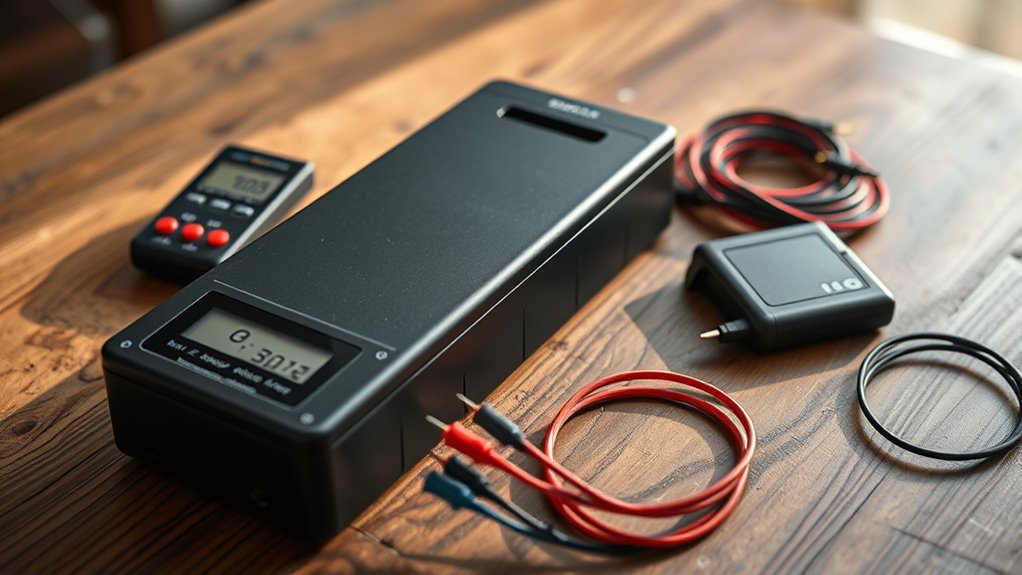
To keep your e-bike’s battery healthy, using the right charging voltage is essential. Smart chargers can automatically adjust settings to prevent overcharging and extend battery lifespan. Choosing the correct tools guarantees your bike stays reliable and performs at its best. Additionally, selecting durable materials for your battery and components can significantly impact its longevity and performance.
Ideal Charging Voltage
Have you ever wondered what the ideal charging voltage for your e-bike’s battery is? The correct voltage guarantees peak charging cycles and prolongs battery life. Typically, lithium-ion batteries charge at around 4.2 volts per cell, but maintaining this voltage through proper regulation helps prevent overcharging or undercharging. Proper automation in charging systems can optimize voltage levels to enhance battery health.
Here’s a simple guide:
| Voltage Level | Suitable for | Notes |
|---|---|---|
| 4.2V per cell | Full charge, peak use | Avoid exceeding to prevent damage |
| 4.1V–4.2V | Daily charging | Balances longevity and performance |
| Below 4.1V | Storage or preservation | Reduces stress on the battery |
Sticking to these voltages supports healthy cycling, which extends your e-bike’s battery lifespan.
Smart Charger Benefits
Smart chargers enhance your e-bike’s battery management by automatically adjusting charging parameters to maximize performance and longevity. Their smart charger advantages include preventing overcharging, reducing heat buildup, and maintaining battery health over time. Additionally, they can optimize charging speed without sacrificing safety or battery life. Here are some key benefits:
- Faster charging with controlled charging speed
- Reduced risk of battery damage
- Precise voltage and current regulation
- Extended battery lifespan through ideal charging cycles
Using a smart charger ensures your e-bike charges efficiently and safely, saving you time and money. By adapting to your battery’s needs, these chargers help maintain peak performance and prolong your battery’s overall health, making them a wise investment for any e-bike owner.
Tips for Extending Your Battery’s Overall Lifespan
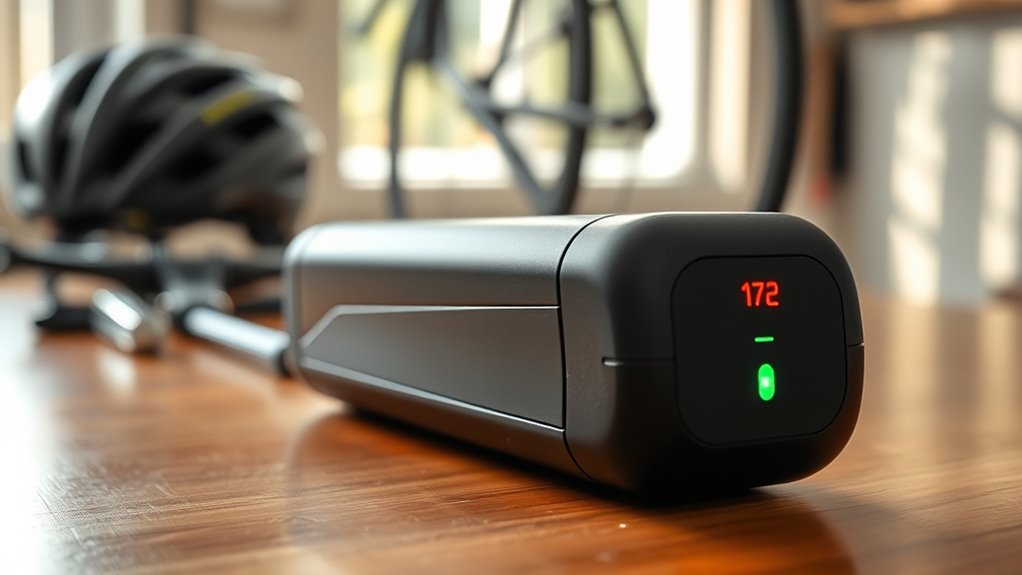
Maintaining your battery’s health requires mindful habits, especially since batteries naturally degrade over time. To extend its lifespan, avoid frequent deep discharges and keep your battery between 20% and 80% charge. Use a smart charger that prevents overcharging, which can damage the cells. Store your e-bike in a cool, dry place to reduce capacity loss caused by heat. Regularly check for firmware updates that optimize charging cycles. When your battery reaches the end of its life, prioritize battery recycling to minimize environmental impact. Proper disposal not only conserves resources but also prevents harmful chemicals from polluting the environment. By adopting these habits, you help prolong your battery’s lifespan and support eco-friendly practices.
Frequently Asked Questions
How Does Temperature Affect Battery Degradation Over Time?
Temperature critically impacts your battery’s degradation over time. High thermal effects accelerate chemical instability, causing faster breakdown of battery components. Conversely, cold temperatures can reduce chemical activity, temporarily decreasing performance but potentially harming long-term stability. Maintaining ideal temperatures helps preserve chemical stability, minimizing degradation. So, avoid exposing your e-bike battery to extreme heat or cold, and store it in a cool, dry place to extend its lifespan and keep it functioning effectively.
Can Using Fast Chargers Damage My E-Bike Battery?
Using fast chargers may seem tempting, but it can gently shorten your e-bike battery’s lifespan if used frequently. The quick boost generates more heat, which accelerates wear over time. To protect your battery’s health, adopt smart charging habits—occasional fast charging is fine, but regular slow charging helps preserve its longevity. This way, you enjoy a more durable battery, keeping your rides smooth and reliable longer.
What Are the Environmental Impacts of Battery Disposal?
You should be aware that improper disposal of e-bike batteries can harm the environment because they contain toxic materials like heavy metals. By following recycling strategies, you help prevent these substances from polluting soil and water. Recycling ensures that valuable materials are recovered and reused, reducing waste and environmental impact. Always take your used batteries to authorized recycling centers to safeguard ecosystems and promote sustainable practices.
How Often Should I Calibrate My Battery’s Capacity?
You should calibrate your battery’s capacity every 3 to 6 months to maintain accuracy. Regular battery calibration helps ensure your device’s capacity readings stay precise, so you won’t run out of power unexpectedly. To do this, fully charge your battery, then use it until it’s completely drained, and recharge it fully without interruption. This process recalibrates the battery’s capacity measurement, giving you a more reliable indicator of remaining charge.
Are There Any Safety Risks With DIY Battery Repairs?
DIY battery repairs pose significant safety risks if you’re not careful. You might accidentally cause a short circuit, which can lead to overheating or even fires. Battery safety is vital, and handling internal components without proper knowledge or tools increases your risk of shock or damage. If you’re unsure, it’s best to consult a professional. Taking shortcuts could compromise your safety and the longevity of your battery.
Conclusion
So, after all this advice, you’d think caring for your e-bike battery is simple. But here’s the irony: the more you obsess over perfect charging habits, the more unpredictable your battery’s lifespan seems. Maybe it’s just nature’s way of reminding us that no matter how much we try to control it, batteries still have a mind of their own. So, enjoy your ride—your battery might just surprise you, one way or another.









